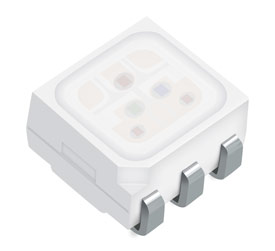- News
7 August 2013
Osram’s multi-chip MultiLEDs give automobile designers more color options
With colors playing an increasingly important role in the automotive sector. the interior lighting can also be tailored to a customer’s individual taste. Osram Opto Semiconductors GmbH of Regensburg says that, due to the wide blue color range of its new RGB MultiLED, lighting designers have a virtually unlimited choice of colors for ambient lighting, including customer-specific colors. Color design now covers cluster lighting to an increasing extent, notably in combined instruments such as speedometers and RPM indicators, in infotainment and GPS displays, as backlighting for switches, and in accent, ambient and trim lighting. Vehicles are fast becoming objects of individual design, the firm adds.
 Picture: Osram’s new RGB MultiLED.
Picture: Osram’s new RGB MultiLED.
The main feature of the new MultiLED is a broad blue color range with a wavelength of 447-476nm and high brightness. Due to the use of a red chip, a green chip and a blue chip (RGB), deep saturated blue tones can now be produced. Other properties of the MultiLED, such as its integrated ESD (electrostatic discharge) protective diode (2kV), its improved corrosion resistance, and its longtime market availability, make the LEDs suitable for use in automobiles.
All shades of blue
At 370 millicandelas (mcd), the blue is much brighter than in other multi-chip LEDs on the market, it is claimed. This brightness is a significant advantage because the sensitivity of the human eye causes the color blue to be perceived as darker than it actually is, notes the firm. “The new LED can offset this darker perception so that customer brightness requirements can be met for all color ranges,” says David Rousseau, LED product marketing manager. “What’s more, a short-wave blue color has a pleasant saturated appearance,” he adds. “We have now succeeded in implementing this color range in an RGB LED version.”
Due to their finely defined grouping (binning), the three independently controllable blue, red and green LED chips in the MultiLED are available in different brightness groups, which can be individually combined to produce a large color spectrum. The blue and green chips are the product of Osram Opto’s UX:3 technology while the red chip is the product of its latest thin-film technology. The light is extracted from the chip with high efficiency, resulting in high luminous intensity, claims the firm. For example, in the upper blue wavelength range, at an operating current of 20mA a level of up to 560 millicandelas is achieved (where luminous intensity in candelas corresponds to luminous flux in lumens (lm) emitted by a light source in a particular solid angle). The typical thermal resistance between the chip and the solder point is 127K/W for blue and green, and 96K/W for red.
The standard SMT package measures 3.3mm x 3.0mm x 1.8mm and has the same footprint as the predecessor version. Since it was developed specifically for applications in the automotive sector, the MultiLED meets all the requirements of an automotive-certified component, says Osram Opto.





